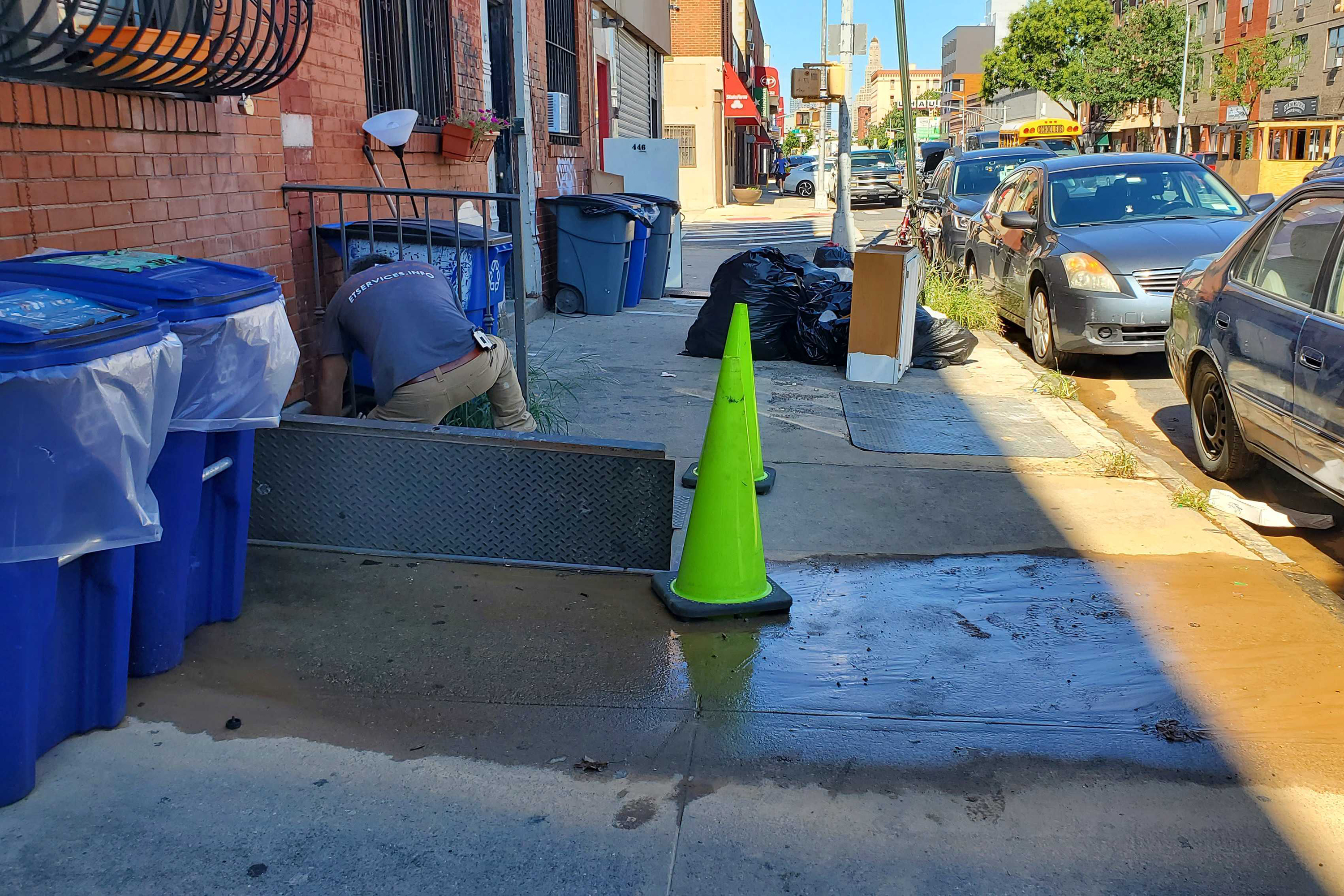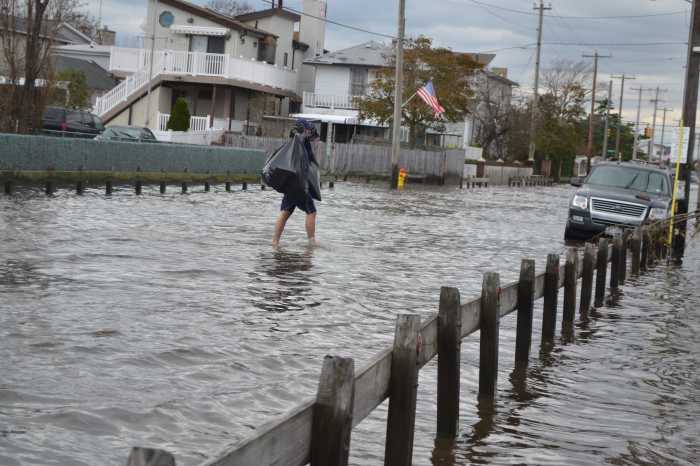This story was originally published on Sept. 2 at 9:24 p.m. by THE CITY. Sign up here to get the latest stories from THE CITY delivered to you each morning.
Between the remnants of Hurricanes Ida and Henri, New Yorkers have been walloped by water this summer, with some finding their homes flooded for the first time.
Basement apartments were especially hard-hit by Ida, with most of the city’s deaths coming in below-grade homes. Meanwhile, some neighborhoods far from areas that typically see coastal or storm surge flooding were swamped.
If you’re facing down a water-logged home, here is some information and resources to help you start picking up the pieces.
How do I start cleaning up, and when?
First thing: Be very cautious about going back into your home after a flood.
Water can weaken a building’s structure, standing water may be electrified and there’s a good chance stormwater contains sewage and hazardous chemicals.
Always wear protective gear — including gloves, boots and a mask — when investigating a place that’s been flooded, the Red Cross and city Department of Buildings recommend.
Never wade into standing water, and if you need to pump water out of underground areas, do it slowly to avoid a potential cave-in of damaged walls.
If the water has receded or been pumped out and it’s safe to start cleaning up, don’t grab the mop first — get your camera.
“Before you throw away anything, before you cut your walls, you should photograph everything,” said Peter Gudaitis, executive director of New York Disaster Interfaith Services.
Whether it’s for a potential insurance claim down the line, a court fight with your landlord over repairs (more on that later) or to later apply for federal disaster assistance, you’re going to need proof of the damage, Gudaitis said.
“When you throw things out on the street, take photographs of what was there,” he said. “You want to document everything. Everything that you buy — keep the receipt … clothing, furniture, appliances, vehicles.”
What to save, what to scrap
Get ready to throw out a lot. Anything porous that flood waters touched should be considered contaminated by sewage and trashed, experts say.
“Anything that it’s not fully sealed, that you can’t wash, you want to make sure you throw that out,” said Michael de Vulpillieres, a spokesperson for the Red Cross of Greater New York.
That includes food, toiletries, clothing, mattresses, sofas and even appliances — because the water often ruins their electronics, Gudaitis noted.
“The biggest worry is that people will try to keep things that they shouldn’t keep that are just dangerous. You know, ‘The sofa will dry out.’ The sofa will not dry out, safely. That’s just a fact. At the very least it will mildew and most likely it will mold,” he said.
 Eileen Grench/ THE CITY
Eileen Grench/ THE CITYSome hard-surfaced items such as pots and pans can be thoroughly washed and saved. But anything that could absorb water has to go — including the walls of your apartment.
“Once drywall is wet, it’s done,” Gudaitis said. “Its strength is gone, and it will mold.”
Walls, insulation and flooring will likely need to be replaced, even with relatively minor flooding: Several inches can do serious damage.
If I have to leave my flooded apartment, where can I go?
Short-term, the Red Cross is helping a limited number of households displaced by Ida find shelter in hotels, de Vulpillieres said. To get housing help, call 311.
“We want people to call 311 if they’ve had flooding in their homes and they have to leave, or they think they might have to leave,” he said. “We work really closely with the city, so they’ll refer us to those people that need housing.”
New Yorkers in need may also call the Red Cross hotline at (877) RED-CROSS.
All New Yorkers have a right to shelter in the city, and the Department of Homeless Services runs shelter intakes centers 24 hours a day. For more information, visit this page from the Coalition for the Homeless.
How can I pay for repairs and replacements, and where can I get financial help?
For renters, Gudaitis said to bear in mind that repairs to an apartment are a “landlord’s responsibility, flat out” and your building’s owner cannot charge rent while your home is unsafe to occupy.
“Landlords are 100% responsible for everything except for [renters’] possessions,” he said.
Making sure landlords abide by that rule, however, can be tough. Having proof of damage — in case legal action is necessary — is key, Gudaitis advised. The city’s Department of Social Services has more information on how to get legal help for housing issues here.
 Hiram Alejandro Durán/ THE CITY
Hiram Alejandro Durán/ THE CITYTenants are responsible for the cost of their own ruined personal belongings. You may get some relief if you have renters insurance. But flooding is not automatically covered under a basic renters policy, according to the city’s Department of Financial Services.
- Here’s a guide from the DFS on how to file a flood insurance claim.
- The DFS also has a Disaster Hotline for insurance help: (800) 339-1759
- For those who want to file a claim against the city for flood damage, fill out this form with the City Comptroller’s Office.
But many city homeowners aren’t insured for flooding, especially in neighborhoods that don’t appear on coastal flood maps.
“We have a serious issue. People in areas like Crown Heights don’t have flood insurance because, why would they?” said Beth Malone, a program manager for resiliency and insurance at NHS Brooklyn, an affordable housing nonprofit.
There is not a huge amount of cash assistance yet available in the aftermath of Ida, said Aaron Sturm, program manager at the nonprofit Center for NYC Neighborhoods, which runs FloodHelpNY, a state-funded flood recovery hub.
For policymakers, finding “alternative ways of freeing up grants and cash immediately after a disaster” should be a priority, Sturm said.
“We know that this is going to be happening more frequently. And we know that especially low- to moderate-income homeowners are the least able to recover and are usually the hardest hit,” he said.
Gudaitis said it may be possible that Gov. Kathy Hochul could soon request a presidential disaster declaration for New York, which would do a lot to help with cash flow for Ida’s victims.
Similar declarations followed Superstorm Sandy, and were recently made in Louisiana and Mississippi after Ida landed there. If President Joe Biden made that call, funds from the Federal Emergency Management Agency could be made available to quickly reimburse New Yorkers coping with damage from Ida.
“If individual assistance is approved, you simply call up on the phone and you say what happened to your house and they decide on the spot what kind of money you’re entitled to,” Gudaitis said.
If everything goes smoothly, funds arrive within a few days. But FEMA assistance is limited, and often doesn’t cover all losses. The maximum amount awarded to any household during a given disaster is $34,900.
THE CITY is an independent, nonprofit news outlet dedicated to hard-hitting reporting that serves the people of New York.

































